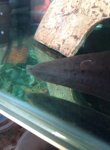Spice2905
New member
Hi this is Luna my very photogenic first axolotl. I've had her for a couple of months now but for the past couple of weeks I have noticed that the very tip of her tail seems to be very slowly flaking away?
It has turned a clear translucent colour and looks very thin, it is gradually flaking away and I don't know what this is or how to treat it?
I have ordered a water testing kit as I do not yet own one, however yesterday I did a complete water change and she seems happier, but the tail looks no better.
It doesn't look a serious issue yet and doesn't seem to be affecting her in any way but I would like to treat this now, any ideas as to what it could be or how to cure would be deeply appreciated



Sent from my GT-I8190 using Tapatalk
It has turned a clear translucent colour and looks very thin, it is gradually flaking away and I don't know what this is or how to treat it?
I have ordered a water testing kit as I do not yet own one, however yesterday I did a complete water change and she seems happier, but the tail looks no better.
It doesn't look a serious issue yet and doesn't seem to be affecting her in any way but I would like to treat this now, any ideas as to what it could be or how to cure would be deeply appreciated



Sent from my GT-I8190 using Tapatalk
